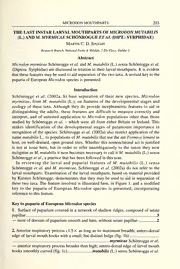
The last instar larval mouthparts of Microdon mutabilis (L.) and M. myrmicae Schonrogge et al (Dipt.: Syrphidae) PDF
Preview The last instar larval mouthparts of Microdon mutabilis (L.) and M. myrmicae Schonrogge et al (Dipt.: Syrphidae)
MICRODONMOUTHPARTS 203 THE LASTINSTARLARVALMOUTHPARTS OFMICRODONMUTABILIS (L.)ANDM. MYRMICAESCHONROGGEETAL(DIPT.: SYRPHIDAE) MartinC. D. Speight ResearchBranch,NationalParks& Wildlife, 7ElyPlace,Dublin2. Abstract Microdon myrmicae Schonrogge etal. andM. mutabilis (L.) sensu Schonrogge etal. (Diptera: Syrphidae) are discussed in relation to theirlarval mouthparts. It is evident thatthesefeatures maybe usedto aid separation ofthe two taxa.Arevisedkey to the pupariaofEuropeanMicrodon species ispresented. Introduction Schonrogge et al. (2002a, b) base separation of their new species, Microdon myrmicae, from M. mutabilis (L.), on features of the developmental stages and ecology of these taxa. Although they do provide morphometric features to aid in distinguishing the adults, these features are difficult to measure correctly and interpret, and of untested application to Microdon populations other than those studied by Schonrogge et al. - which were all from either Britain or Ireland. This makes identification of the developmental stages of paramount importance in recognition ofthe species. Schonrogge et al. (2002a) also restrict application ofthe namemutabilis L., to populations ofM. mutabilis that use the antFormica lemani as host, on well-drained, open ground sites. Whether this nomenclatural act isjustified is not at issue here, but in order to refer unambiguously to the taxon they now recognise asM. mutabilis itnow becomes necessary tocall itM. mutabilis (L.) sensu Schonroggeetal., apracticethathasbeenfollowedin this note. In reviewing the larval and puparial features of M. mutabilis (L.) sensu Schonrogge et al. and M. myrmicae, Schonrogge et al. (2002a) do not refer to the larval mouthparts. Examination ofthe larval mouthparts, based on material provided by Karsten Schonrogge, demonstrates that they may be used to aid in separation of these two taxa. The feature involved is illustrated here, in Figure 1, and a modified key to the puparia of European Microdon species is presented, incorporating referencetothisfeature. KeytopupariaofEuropeanMicrodon species 1. Surface ofpuparium covered in a network ofshallow ridges, composed ofsetate —papillae 3 mostofdorsumofpuparium smooth andbare, withoutsetatepapillae 2 2.Anteriorrespiratory process cl.5X as long as its maximum breadth; antero-dorsal edgeoflarval mouthhooks withasmall, butdistinctbulge (fig. lb) — myrmicae Schonroggeetal. anteriorrespiratory process broaderthan high; antero-dorsal edge oflarval mouth hooks smoothlycurved (fig. lc) mutabilis (L.) sensu Schonroggeetal. 204 ENTOMOLOGIST'SRECORD,VOL. 114 25.ix.2002 3. Bare patches within the network of setate papillae no broader than the basal —diameteroftheposteriorspiracularprocess 4 bare patches within the network of setate papillae including some on the dorsal half of the puparial surface which are 2X as broad as the basal diameter of the posteriorspiracularprocess (anteriorrespiratory horns more than 2X as long astheir basal diameterandvery strongly curved) devius (L.) 4. Anterior respiratory horns more than 2X as long as their basal diameter and straight; distance between dorsal and ventral edges of mouth hook greater in the —distal thirdofits lengththan inthe medianthirdofits length analis (Macquart) anterior respiratory horns less than 2X as long as their basal diameter; distance between dorsal and ventral edge of mouth hook greater in the median third of its length than inthedistal thirdofits length mikiDoczkal & Schmid(notknown to occurineitherIrelandorGreatBritain) 4 Fig.l: Microdonfinal instarlarvalmouthparts. a=mouthpartsofM.myrmicae, asfoundattached antero-mediallyontheinnersurfaceofthefloorofthepuparium;b=mouthhookofM.myrmicae, arrow indicating bulge on dorsal edge; c = mouth hook ofM.mutabilis sensu Schonrogge et al, showingsmoothlycurveddorsaledge(seetext). MICRODONMOUTHPARTS 205 The mouthparts of the mature larva are sclerotised and remain attached to the inner, ventral wall of the puparium, and so are available for examination in a recently hatched puparium. Karsten Schonrogge kindly provided me with empty pupariaofbothM. myrmicae andM. mutabilis (L.)sensu Schonroggeetal, complete with the plates carrying the anterior respiratory processes (henceforth referred to as ARP), which are diagnostic for these taxa. The larval mouthparts were carefully removed from these puparia (n = 4, in each case), and compared, revealing the differences in the mouth hooks alluded to above. The possibility of distinguishing these two taxa based on features of the larval mouth hooks extends the range of identifiable material to include puparia from which the ARP have been lost, but the larval mouthparts remain attached. This may seem only a marginal improvement in the previous situation. However, theARP are located on a plate which is burst open during the process of eclosion of the adult insect from the puparium, the separate pieces of this plate then usually becoming detached from the puparium. Freshly hatched puparia collected from an ants' nest may thus lack theARP, rendering them unidentifiable if determination is based entirely on ARP features. The larval mouthparts are not affected by eclosion ofthe adult and thus remain attached to the puparium. For how long empty puparia ofM. myrmicae may remain available after eclosion of the adult is uncertain, since the ant host (Myrmica scabrinodis) apparently normally destroys the empty puparia (Schonrogge, pers. comm.). However, puparia of M. mutabilis (L.) sensu Schonrogge et al. are not so immediately destroyed by their ant host {Formica lemani), so the potential for confirmation oftheir identity from examination ofattached larval mouthparts could prove useful. It is to be hoped that the differences in their larval mouthparts can also beusedinconfirmation ofthe identity ofthelarvae ofthesetwoMicrodon species. Acknowledgements I am extremely grateful to Karsten Schonrogge forpuparia ofbothM. myrmicae and M. mutabilis sensu Schonrogge etal, and forhis considerable patience in answering my numerous queries concerningM. myrmicae. References Schonrogge, K., Barr, B., Wardlaw, J. C, Napper, E., Gardner, M. G., Breen, J., Elmes, G. W. & Thomas, J. A. (2002a). When rare species become endangered: cryptic speciation in myrmecophiloushoverflies.BiologicalJ. Linn. Soc.75: 291-300. - (2002b) Addendum. When rare species become endangered: cryptic speciation in , myrmecophiloushoverflies.BiologicalJ. Linn. Soc.76: 315.
